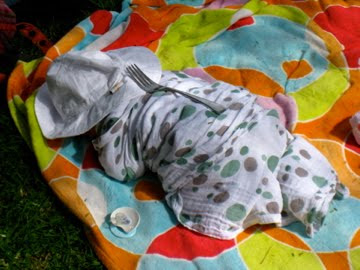Every morning on the block of Orizaba between 20 de enero and 28 de abril a woman about 60 years old sweeps the street for about 50 yards on either side of her door. She looks to have just woken up. Her hair is a pile of frizz, and she wears a poly-cotton house dress that goes from the neck to about mid-calf, printed in either blue and white checks, or a pink and white floral, with a row of snaps from top to bottom. On her feet are grey socks bunched up around her ankles and a pair of dusty, gray men's loafers. We pass her at 7:37 every morning, as we head to the bus stop on our new route up 28 de abril (less incline, wider sidewalk, fewer unbroken cobblestones). When cars come down Orizaba, she stands on the sidewalk, guarding her pile from blowing away in their exhaust, then she resumes the gathering of the night's bougainvillea leaves and snack wrappers.
I saw her two days ago on Calzada de la Aurora, about a mile from home, on the other side of town. Incredibly she was dressed: in a colorless suit and stockings and the same flat, black slip-ons that all Mexican senoras wear. I don't know that I would have recognized her outside of the neighborhood. But she had the same lopsided smile from a cleft palate that never got repaired.
In Spanish immersion class at Habla Hispana, my teacher Enrique speaks of voces en la calle, street slang or literally, voices in the street, as he tries to teach us to speak less academically and more like a local. I love this phrase. It makes me think also of the faces in the street, caras en la calle, that I see regularly. San Miguel is a small town; its eccentrics and vendors and beggars and street sweepers become familiar very quickly. Here are a few of the people you will see if you visit San Miguel, if not the first day, by the end of your week.
 |
| The knife sharpener on his bicycle. |
 |
| Everisto, our favorite horse cop, dressed as a Wise Man for Navidad. |















































